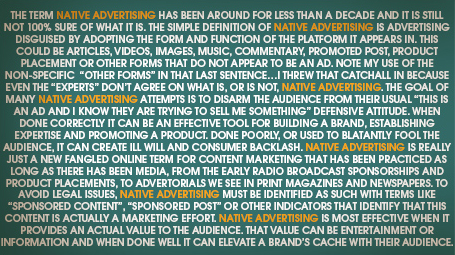Should you go native?

The term Native Advertising has been around for less than a decade and it is still not 100% sure of what it is.
The simple definition of Native Advertising is advertising disguised by adopting the form and function of the platform it appears in.
This could be articles, videos, images, music, commentary, promoted post, product placement or other forms that do not appear to be an ad.
Note my use of the non-specific “other forms” in that last sentence…I threw that catch-all in because even the “experts” don’t agree on what is, or is not, Native Advertising.
The goal of many Native Advertising attempts is to disarm the audience from their usual “this is an ad and I know they are trying to sell me something” defensive attitude.
When done correctly it can be an effective tool for building a brand, establishing expertise and promoting a product. Done poorly, or used to blatantly fool the audience, it can create ill will and consumer backlash.
Native Advertising is really just a new fangled online term for content marketing that has been practiced as long as there has been media, from the early radio broadcast sponsorship and product placements, to advertorials we see in print magazines and newspapers.
To avoid legal issues, Native Advertising must be identified as such with terms like “sponsored content”, “sponsored post” or other indicators that identify that this content is actually a marketing effort.
Native Advertising is most effective when it provides an actual value to the audience. That value can be entertainment or information and when done well it can elevate a brand’s cache with their audience.
Before you go Native, ask yourself, is the information or entertainment you plan on sharing relevant to your audience or only to your marketing goals?

